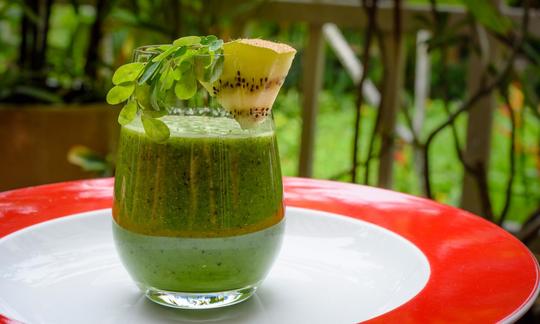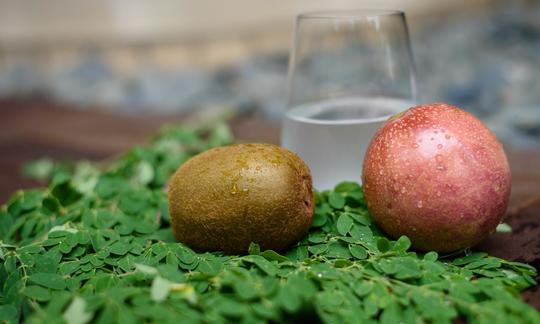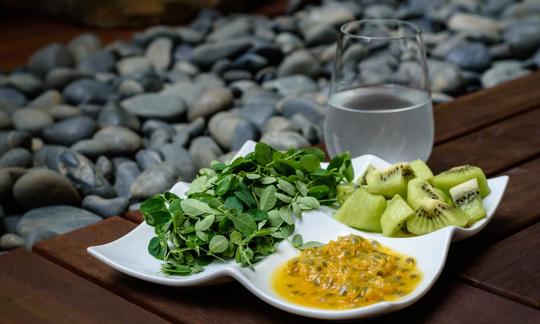Moringa Smoothie with Passion Fruit and Kiwi
raw-vegan
Ingredients (for serving, )
| ½ cup, chopped | Horseradish tree, raw leaves (Moringa, miracle tree, organic?) (0.37 oz) |
| 1 | Kiwi, green (raw, organic?) (3.9 oz) |
| 1 | Passion fruit, purple, raw (organic?) (2.3 oz) |
| 250 ml | Coconut water, raw? (Coconut water, coconut juice, organic?) (8.9 oz) |
Equipment
- blender or hand-held blender / immersion blender or food processor
Type of preparation
- chop or grind
- food preparation without heating
- blend
- peel
Preparation
Prepare the smoothie
Wash and coarsely chop the moringa leaves. Peel the kiwi and quarter if necessary (depending on the size of your blender).Blend all the ingredients until smooth.
Moringa leaves have a slightly spicy flavor, so you may want to begin with a smaller amount of leaves than is called for in the recipe. You may also increase the amount of fruit or coconut water as necessary.
Garnish and serve
Pour the smoothie into a large glass and garnish with a kiwi slice. This moringa smoothie is also delicious when served chilled.
|
Nutritional Information per person
Convert per 100g
|
2000 kcal | |
|---|---|---|
| Energy | 186 kcal | 9.3% |
| Fat/Lipids | 1.7 g | 2.4% |
| Saturated Fats | 0.54 g | 2.7% |
| Carbohydrates (inc.dietary fiber) | 42 g | 15.5% |
| Sugars | 24 g | 26.6% |
| Fiber | 13 g | 52.7% |
| Protein/Albumin | 5.5 g | 11.0% |
| Cooking Salt (Na:289.2 mg) | 734 mg | 30.6% |
| Essential micronutrients with the highest proportions | per person | 2000 kcal | |
|---|---|---|---|
| Vit | Vitamin E, as a-TEs | 26 mg | 220.0% |
| Vit | Vitamin C (ascorbic acid) | 133 mg | 167.0% |
| Vit | Vitamin K | 57 µg | 75.0% |
| Elem | Potassium, K | 1'243 mg | 62.0% |
| Sodium, Na | 289 mg | 36.0% | |
| Min | Copper, Cu | 0.31 mg | 31.0% |
| Min | Manganese, Mn | 0.58 mg | 29.0% |
| Elem | Magnesium, Mg | 106 mg | 28.0% |
| Vit | Vitamin B6 (pyridoxine) | 0.34 mg | 25.0% |
| Vit | Folate, as the active form of folic acid (née vitamin B9 and | 49 µg | 24.0% |
Detailed Nutritional Information per Person for this Recipe
The majority of the nutritional information comes from the USDA (US Department of Agriculture). This means that the information for natural products is often incomplete or only given within broader categories, whereas in most cases products made from these have more complete information displayed.
If we take flaxseed, for example, the important essential amino acid ALA (omega-3) is only included in an overarching category whereas for flaxseed oil ALA is listed specifically. In time, we will be able to change this, but it will require a lot of work. An “i” appears behind ingredients that have been adjusted and an explanation appears when you hover over this symbol.
For Erb Muesli, the original calculations resulted in 48 % of the daily requirement of ALA — but with the correction, we see that the muesli actually covers >100 % of the necessary recommendation for the omega-3 fatty acid ALA. Our goal is to eventually be able to compare the nutritional value of our recipes with those that are used in conventional western lifestyles.
| Essential fatty acids | per person | 2000 kcal |
|---|---|---|
| Linoleic acid; LA; 18:2 omega-6 | 0.55 g | 5.0% |
| Alpha-Linolenic acid; ALA; 18:3 omega-3 | 0.05 g | 2.0% |
| Essential amino acids | per person | 2000 kcal |
|---|---|---|
| Tryptophan (Trp, W) | 0.05 g | 21.0% |
| Threonine (Thr, T) | 0.16 g | 17.0% |
| Valine (Val, V) | 0.24 g | 15.0% |
| Isoleucine (Ile, I) | 0.18 g | 14.0% |
| Leucine (Leu, L) | 0.29 g | 12.0% |
| Phenylalanine (Phe, F) | 0.19 g | 12.0% |
| Lysine (Lys, K) | 0.20 g | 11.0% |
| Methionine (Met, M) | 0.07 g | 8.0% |
| Vitamins | per person | 2000 kcal |
|---|---|---|
| Vitamin E, as a-TEs | 26 mg | 220.0% |
| Vitamin C (ascorbic acid) | 133 mg | 167.0% |
| Vitamin K | 57 µg | 75.0% |
| Vitamin B6 (pyridoxine) | 0.34 mg | 25.0% |
| Folate, as the active form of folic acid (née vitamin B9 and | 49 µg | 24.0% |
| Riboflavin (vitamin B2) | 0.33 mg | 23.0% |
| Thiamine (vitamin B1) | 0.13 mg | 12.0% |
| Niacin (née vitamin B3) | 1.8 mg | 11.0% |
| Vitamin A, as RAE | 86 µg | 11.0% |
| Biotin (ex vitamin B7, H) | 3.3 µg | 7.0% |
| Pantothenic acid (vitamin B5) | 0.32 mg | 5.0% |
| Essential macroelements (macronutrients) | per person | 2000 kcal |
|---|---|---|
| Potassium, K | 1'243 mg | 62.0% |
| Sodium, Na | 289 mg | 36.0% |
| Magnesium, Mg | 106 mg | 28.0% |
| Phosphorus, P | 145 mg | 21.0% |
| Calcium, Ca | 126 mg | 16.0% |
| Essential trace elements (micronutrients) | per person | 2000 kcal |
|---|---|---|
| Copper, Cu | 0.31 mg | 31.0% |
| Manganese, Mn | 0.58 mg | 29.0% |
| Iron, Fe | 2.6 mg | 18.0% |
| Selenium, Se | 3.2 µg | 6.0% |
| Zinc, Zn | 0.54 mg | 5.0% |
| Iod, I (Jod, J) | 0.86 µg | 1.0% |
With its combination of nutrient-dense ingredients, this delicious and fruity moringa smoothie with passion fruit and kiwi is a nutritious and refreshing treat.
Moringa tree: Common names include moringa, drumstick tree (from the long, slender, triangular seed-pods), and horseradish tree. The moringa tree is cultivated extensively in Southeast Asia, where the leaves and seeds are used as food and for medicinal purposes. The leaves are the most nutritious part of the plant. They are such a significant source of calcium, potassium, beta-carotene, and iron that they are used to combat malnutrition and boost food security in developing countries.
Vitamin B12 and moringa: As nutritious as moringa is, be careful of sources claiming that moringa contains vitamin B12. The B12 in moringa is an inactive B12 analog and can cause a vitamin B12 deficiency in the body by blocking the B12 receptors. This means that moringa is not a source of B12, especially for vegans and vegetarians.
Coconut water: Coconut water is an isotonic substance that is easily absorbed and processed by our bodies. This means that coconut water is a good source of liquids for hydration and thirst quenching. It contains more vitamins and minerals than plain water, with just a trace of fat. Coconut water is obtained from young, fresh coconuts or packaged in Tetra Paks. The coconut water from the brown coconuts that are sold for coconut meat in supermarkets often tastes sour and spoiled. It does not have a taste comparable to that of the coconut water from young coconuts.
Passion fruit: Passion fruit is also known as maracuja. There are numerous varieties of passion fruit available, but the most popular are the brownish-purple ones that look somewhat shriveled when ripe, and the yellowish-green passion fruit. Passion fruit is rich in vitamins C and B, magnesium, and calcium. The seeds are a good source of unsaturated fatty acids.
Kiwi: Fuzzy round kiwis are known for their typical sweet and sour taste and green color. They contain high levels of vitamin C and are low in calories.
Moringa powder: Moringa leaves are often dried and powdered. They are sold as a dietary supplement in capsule form and as loose powder. Keep in mind that taking Moringa oleifera supplements in capsule or powder form will not supply the amount of nutrients that you would receive from the whole leaves. Choose fresh moringa leaves whenever possible. They are often available at Indian markets.
Other fruits: You can substitute any combination of fruits for kiwi and passion fruit. The combinations are only limited by your imagination.








